Get With the Programs
By Mark Ray
BOY SCOUTING
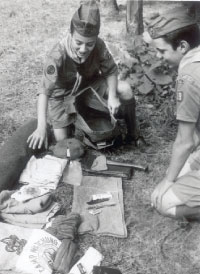 Boy Scouting, the oldest branch of the Boy Scouts of America, officially began in 1910 with the founding of the BSA. But the program actually came to the United States in 1908 when overseas travelers started bringing home copies of Robert Baden-Powell’s Scouting for Boys.
Boy Scouting, the oldest branch of the Boy Scouts of America, officially began in 1910 with the founding of the BSA. But the program actually came to the United States in 1908 when overseas travelers started bringing home copies of Robert Baden-Powell’s Scouting for Boys.
Despite its longevity, Boy Scouting has changed far less since its early days than the other branches of Scouting. Scoutmasters still lead troops and senior patrol leaders, patrols still name themselves after owls and foxes, and Scouts still strive for the Eagle Scout Award. The Scout Oath, Law, Motto, and slogan haven’t changed a bit.
That’s not to say the program has remained the same, however. Long gone are the choke-collar uniform shirts and knickerbockers, as are merit badges for blacksmithing, poultry farming, and stalking (which had a very different meaning 100 years ago). But an early 20th-century Scout would probably fit right in at a modern Scout meeting.
CUB SCOUTING
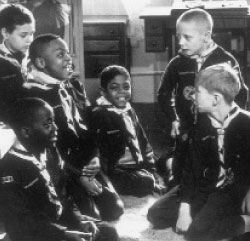 As Boy Scouting grew in popularity, younger boys began asking to join. While some became unofficial “junior Scouts” or “mascots,” they’d have to wait years until they got their own program.
As Boy Scouting grew in popularity, younger boys began asking to join. While some became unofficial “junior Scouts” or “mascots,” they’d have to wait years until they got their own program.
That program, originally called Cubbing, started in America in 1930. Based on a British model, it mixed themes from Rudyard Kipling’s The Jungle Book with Native American traditions.
Early Cub Scouts advanced from Bobcat (for all members) to Wolf (age 9), Bear (age 10), and Lion (age 11) before joining Boy Scouting at age 12. The BSA lowered its age requirements by a year in 1949. The Webelos rank replaced the Lion rank in 1967, and Tiger Cubs first roared in 1982. Age requirements dropped one more time in 1986.
The other big change came in leadership: Initially, Cubmasters were always men, while den mothers—as the name indicates—were always women. By the 1970s, however, men and women could hold any leadership position.
VENTURING
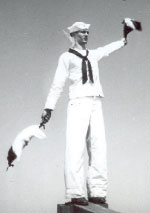 Though Venturing is the BSA’s youngest program, it boasts a pedigree dating back to 1912—when Sea Scouts first set sail in Massachusetts. Sea Scouting was joined by a land-based alternative, Explorer Scouts, in 1935 and by Air Scouts in 1942. Each program featured its own uniform and advancement plan.
Though Venturing is the BSA’s youngest program, it boasts a pedigree dating back to 1912—when Sea Scouts first set sail in Massachusetts. Sea Scouting was joined by a land-based alternative, Explorer Scouts, in 1935 and by Air Scouts in 1942. Each program featured its own uniform and advancement plan.
The three programs came together under the Exploring banner in 1949, and the BSA dropped its advancement plan a decade later. During the 1960s, Exploring began to address six experience areas: citizenship, service, social, vocational, outdoor, and personal fitness.
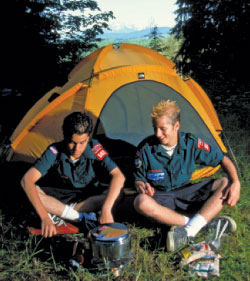 Exploring gradually developed a split personality, with some posts focusing on high-adventure activities and others focusing on career exploration. As a result, the BSA divided Exploring in two in 1998. Career-oriented posts kept the Exploring name and became part of Learning for Life (a BSA subsidiary organization launched in 1991 to oversee in-school programs). Everything else, including Sea Scouting, became part of the new Venturing program.
Exploring gradually developed a split personality, with some posts focusing on high-adventure activities and others focusing on career exploration. As a result, the BSA divided Exploring in two in 1998. Career-oriented posts kept the Exploring name and became part of Learning for Life (a BSA subsidiary organization launched in 1991 to oversee in-school programs). Everything else, including Sea Scouting, became part of the new Venturing program.
VARSITY SCOUTING
Varsity Scouting launched in 1984, but the idea dates back to the mid-1970s when Scouting leaders in the Church of Jesus Christ of Latter-day Saints began searching for ways to retain older Boy Scouts. They hit on the idea of using sports terminology to make their program of high adventure, sports, and service more appealing to their target audience: boys ages 14 through 17. The patrol became the squad; the troop became the team; and the Scoutmaster became the coach.
A cousin to Boy Scouting, Varsity Scouting shares the Scout Oath and Law and adds the Varsity Scout Pledge. Varsity Scouts work toward Boy Scout advancement, but they also can earn Varsity Scout letters (much like the letters worn by high school athletes) and activity pins for sports and high-adventure activities.
Varsity Scouts are expected to schedule high-adventure or sports activities, conduct regular service projects, take part in events with national units or neighboring teams, including those involving girls of similar age, and focus on character development within the framework of their personal and religious beliefs.
The Denali Award, created in 2001, offers a goal beyond the Varsity Scout letter.
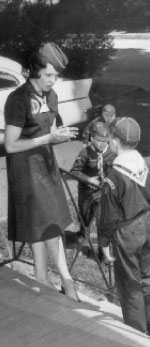 CHANGE: THE ONLY CONSTANT
CHANGE: THE ONLY CONSTANT
Today’s Boy Scouts must earn 21 merit badges (among other things) to earn the Eagle Scout Award. That number has rarely changed, but the assortment of required badges has changed frequently. Some highlights:
- The first list of 11 required badges appeared in 1914. It included the familiar (Camping, First Aid, Lifesaving) and the surprising (Bird Study, Pathfinding, Public Health).
- From 1952-1965, Scouts had to earn 10 required badges plus one from the conservation group, three from the citizenship group, one from the outdoor-sports group, and one from either the animal husbandry, plant cultivation, building, communications, or transportation group.
- In 1972, the BSA dropped Camping and Cooking from the required list and added alternatives to Swimming and Lifesaving. It also increased the total number of badges required to 24.
- Camping returned to the required list in 1979, and the total number of badges required dropped back to 21.
- Cycling and Hiking became the newest options on the required list in 1999. Their only previous appearance had been as part of the outdoor-sports group in the 1950s and ’60s.
FIVE FACTS ABOUT CUB SCOUTING
- The earliest dens were led by den chiefs (Boy Scouts), not adult den leaders. Even the first Den Mother’s Denbook, published in 1937, advised the den mother to “keep somewhat in the background, making the den chief the important figure in the den meeting.”
- The original Cub Scout salute—right arm raised with the palm out—looked too much like the Nazi salute and was quickly changed to the familiar two-fingered touch of the right hand to the forehead.
- The word Webelos originally came from the first letters of the Cub Scout ranks—Wolf, Bear, and Lion—along with Scout. When the BSA dropped the Lion rank in 1967, it changed the slogan to mean “WE’ll BE LOyal Scouts.”
- In 1971, the Cub Scout Promise had to be revised. The phrase “to be square” had taken on a negative meaning in popular culture, so it was replaced with “to help other people.”
- Until 1967, only women could serve as den leaders (then called den mothers). Until 1976, only men could serve as Cubmasters and assistant Cubmasters.
MERIT BADGE QUIZ
The BSA has offered more than 200 merit badges. Here’s a list of badges that may or may not be real. Can you spot the fakes?
- Barbering
- Citizenship in the Home
- Duty to God
- Farm Home and Its Planning
- First Aid to Animals
- Immunization
- Intellectual Property Rights
- Interpreting
- Invention
- Sheep Farming
ANSWERS
Use your cursor to highlight the red box below to reveal the answers to the Merit Badge Quiz.
Answers: 1. Fake, although Scouts in the Philippines can earn it. 2. Real (1952-1972). 3. Fake. That’s what religious emblems cover. 4. Real (1928-1959). 5. Real (1911-1972). 6. Fake, although Scouts in Indonesia can earn it. 7. Fake, although Scouts in Hong Kong can earn it. 8. Real (1911-1952). 9. Real (1911-1917). 10. Real (1928-1975).